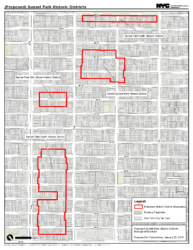
Map of Sunset Park with the four proposed historic districts outlined in red. Image Credit: LPC.
Landmarks research staff spent several years researching the area, surveying and documenting over 4,000 buildings. On January 22, 2019, the Landmarks Preservation Commission unanimously voted to add to its calendar four areas of Sunset Park, Brooklyn for historic district designation. The proposals were presented to the Commission following years of extensive survey and analysis by the Landmarks research staff after a request for evaluation of the area from Sunset Park’s Landmarks Committee in 2014. The Sunset Park Landmarks Committee was established in 2012 by area residents and homeowners who were concerned with redevelopment changing the largely rowhouse-character of the area. To read CityLand coverage on the Committee’s efforts in building community support for designation in its early stages, click here.
Prior to 1890s, Sunset Park was largely farmland. Following the 1889 opening of the 39th Street Ferry to Lower Manhattan, the 1893 extension of the Brooklyn Union Elevated Railway along 3rd Avenue and the development of Bush Terminal along the waterfront, construction of Sunset Park boomed as the need to house port workers and professionals arose. Many of Sunset Park’s rowhouses were constructed as two-family homes to allow the largely immigrant, working-class population of the area to supplement their incomes by taking on renters.
Today, the areas of Sunset Park that are being proposed for designation are those that have retained the late 19th and early 20th century rowhouse characteristics.
Landmarks looked at a study area that extended from 40th Street to 60th Street, and 4th Avenue to 7th Avenue to determine the most meritorious areas of possible designation. Landmarks research staff conducted a building-by-building survey of over 4,000 buildings and documented each building’s date of construction, architectural typology, style and integrity. The research department evaluated the “historic character and cohesiveness of streetscapes” and looked for areas where several blocks connect together to create a “distinct sense of place.”
The research department concluded that the proposed Sunset Park North, Sunset Park South, Central Sunset Park, and Sunset Park 50th Street historic districts are the strongest representation of the neighborhood’s primary periods of historical development and residential typology.
Sunset Park North Historic District
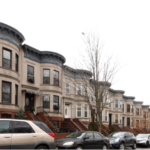
Rowhouses along 44th Street in proposed Sunset Park North Historic District. Image Credit: LPC.
The proposed Sunset Park North Historic District would be comprised of two well-preserved blocks on the south side of 44th Street, between 5th and 7th Avenues containing approximately 56 buildings. The two blocks overlook Sunset Park and are notable for their rows of lime-stone and brick-fronted houses and apartment houses tied to the Brooklyn’s historic Finnish American Community. The houses were designed in the Renaissance Revival style and retain a high degree of historical integrity. Those between 5th and 6th Avenues feature elegant limestone fronts with classical detailing and round projecting bays, while those between 6th and 7th Avenues are somewhat more austere and faced in light-colored brick. The apartment houses were mainly designed in brick with an eclectic mix of classical and Arts and Crafts detailing.
Sunset Park South Historic District
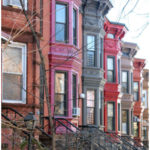
Rowhouses along 54th Street in proposed Sunset Park South Historic District. Image Credit: LPC.
The proposed Sunset Park South Historic District, which would be located along 54th through 59th Streets between 4th and 5th Avenues, consists of approximately 285 buildings. The area is notable for its rows of well-preserved houses that incorporate neo-Grec, Romanesque Revival, and Renaissance Revival details, designed by a number of Brooklyn architects, including Henry Spicer, Thomas Bennett, and Henry Pohlmann. Houses range from the relatively ornate—such as the Renaissance Revival style row at 413 to 433 56th Street (Thomas Bennett, 1899-1901) with their full-height projecting bays, lavish classical reliefs, and deep bracketed cornices—to simpler rows, like the brick-fronted group of 26 houses filling the north blockfront of 59th Street between 4th and 5th Avenues.
Central Sunset Park Historic District
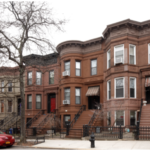
Rowhouses along 48th Street in proposed Central Sunset Park Historic District. Image Credit: LPC.
The proposed Central Sunset Park Historic District would consist of approximately 148 buildings along the north and south sides of 47th and 48th Streets between 5th and 6th Avenues, and along the east and west sides of 6th Avenue, between 47th and 49th Streets. The area is notable for its well-preserved rowhouses that incorporate neo-Grec, Romanesque Revival, and Renaissance Revival details. The proposed district’s row houses are predominantly two stories with high stoops and are clad in brick, limestone, brownstone, or a combination of materials. Their uniform rows create distinctive streetscapes with consistent cornice lines and rhythmically recurring, rounded and angled, fullheight projecting bays. The rowhouses were designed by Thomas Bennet, Henry Pohlmann, Henry Spicer, George Roosen and William Rexer. The proposed district is also home to a handful of brick-fronted flats buildings along 48th Street and 6th Avenue, as well as a neo-Gothic style Park United Presbyterian Church at the southwest corner of 6th Avenue and 48th Street, designed by J.L. Beatty.
Sunset Park 50th Street Historic District
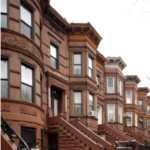
Rowhouses along 50th Street in Proposed Sunset Park 50th Street Historic District. Image Credit: LPC.
The proposed Sunset Park 50th Street Historic District would consist of two rows of 25 houses on 50th Street, between 4th and 5th Avenues. Incorporating the Romanesque Revival and Renaissance Revival styles, all of the houses were designed by Henry Spicer and Thomas Bennett and are of consistent design, featuring high stoops, angled or round projecting bays, and richly textured brownstone fronts.
Landmarks Chair Sarah Carroll called the proposal exciting as this area does not have a lot of landmarks. Chair Carroll also worked on the proposals with the research team and the Sunset Park Landmarks Committee. “Sunset Park is a very special place and really unlike all of our brownstone districts in that these buildings were built as housing for workers on the waterfront…and they are unique in their scale and typologies,” she said.
Vice Chair Frederick Bland said that he wondered how many other places within the boroughs exist, having such cohesiveness, that Landmarks Preservation Commission is unaware of. But given Commission’s relatively short existence, he said that this is likely because the notion of Landmarks changes over time.
CityLand reached out to Lynn Massimo, project lead for the Sunset Park Landmarks Committee for comment on Landmarks calendaring the proposals. In response, Massimo wrote, “We’re over the moon that the LPC is considering 4 historic districts in Sunset Park. It’s been a long time coming. The neighborhood has been on the National Register of Historic Places since the 1980s, but we need the protection of the Landmarks Law. The Sunset Park Landmarks Committee (SPLC) started its efforts for preservation 6 years ago in response to the uptick in rowhouses being altered so drastically that the neighborhood was losing its sense of place and we couldn’t have gotten this far without the guidance of the Historic Districts Council as a HDC “Six to Celebrate” neighborhood. On many blocks, generations of Sunset Parkers have kept their rowhouses intact and looking historic, but rampant redevelopment is erasing that history. That history, which is both the history of architecture and of a community, deserves to be honored and preserved.”
The Landmarks Preservation Commission will hold a public hearing on the proposals at a future date.
By: Viktoriya Gray (Viktoriya is the CityLaw Fellow and New York Law School Graduate, Class of 2018).

